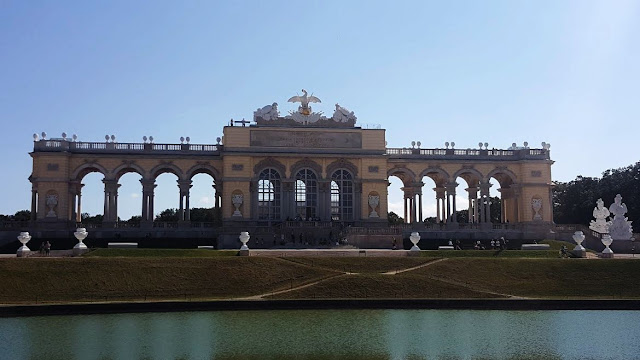I gave an overview of a three days quick travelogue in my previous post that my two sons took to visit three Schengen countries: Austria, Hungry and Slovakia recently. Now here is the detailed travel details and the landmarks of each capital so visited.
Their journey by bus started from Stuttgart, Germany with a halt at Munich, from where one of their friends also joined them for the three days journey ahead. The bus reached Vienna early next day and after refreshing up and a hurried breakfast, they were taken to the major landmarks of the city by the tour guide.
Vienna is the largest city and capital of Austria with a population of around 2.6 millions, nearly one third of Austria's population. Until the beginning of the 20th century, it was the largest German-speaking city in the world, and before the splitting of the Austro-Hungarian Empire in World War I. Today, it has the second largest number of German speakers after Berlin. The city is located in the eastern part of Austria and is close to the borders of the Czech Republic, Slovakia, and Hungary.
The famous Danube River is Europe's second-longest river, after the Volga River. It flows through 10 countries, more than any other river in the world. Originating in Germany, the Danube flows through Austria, Slovakia, Hungary, Croatia, Serbia, Romania, Bulgaria, Moldova and Ukraine before emptying into the Black Sea. The Danube River flows through four national capitals – Vienna (Austria), Bratislava (Slovakia), Budapest (Hungary) and Belgrade (Serbia).
One of the oft visited land mark of Vienna is the 16th century Schönbrunn Palace or the Palace and Gardens of Schönbrunn as it is officially known, is a former imperial summer residence, located in the Hietzing region of Vienna. The palace was named Schönbrunn meaning beautiful spring - synonymous with its lush green gardens full with flowers almost the whole year.
The palace is overlooked by a high ground which gives a commanding view of the palace below
The palaces as viewed from its main entrance side with its two white towering pillars
The sculptured fountain
Wien Michaelerplatz Hofburg or the St. Michael's Wing of Hofburg Palace
Amalienburg, named after Empress Amalie Wilhelmine, the widow of Joseph I is situated across the Swiss Gate and part of the Hofburg Palace.Located in the Hofburg Palace, Wien - Naitonalbibliothek or the Austrian National Library is said to be stocked with 7.4 million items and is the the largest library in Austria. The library is located in the Hofburg Palace complex.
Vienna has majority of Christians Catholics (41.3%) besides some 31.6% owning no religion. It also has a sizable Muslim population of around 11% of the total, mostly Turks, Syrians, Iraqis, Bosnians and Afghanis.
There is a Vienna Islamic Centre in the 21st city district Floridsdorf to cater for the Muslim worshipers of the city.
Vienna is also a city of arts and culture and with arts comes to forth the name of the famous Belvedere Museum. The Museum is in fact a group of buildings consisting of two Baroque palaces (the Upper and Lower Belvedere), the Orangery, and the Palace Stables.
Upper Belvedere Entrance
One of the two Sphinx sculptures in the Belvedere Museum complex
The construction of the buildings started with the Lower Belvedere in the 17th century. The buildings also include decorative tiered fountains and cascades, Baroque sculptures, and majestic wrought iron gates.
Away from palaces, the life in the city is colorful with eateries serving local and other cuisines and it is here one can see the famous red trams of Vienna on the Ring Road (Ringstraße).
My sons posing with Wiener Rathaus in the background. Rathaus is the city hall of Vienna, located on Rathausplatz. The building constructed from 1872 to 1883 in a Neo-Gothic style houses the office of the Mayor of Vienna. The peculiar architecture draws crowds of tourist to have them photographed with it in the background.
My sons posing with the famous Red Tram (below)
The day long tour was really hectic and tiring beside being very educative of history of Vienna. Above my son and his friend rest on a bench, totally exhausted before embarking upon the second phase of their journey to the Hungarian capital of Budapest.
Map | References: Wikipedia | Photos: All photos are the property of Jaho Jalal / Waqaace Jalal Bhatti
Previous Post(s)

























































0 comments:
Post a Comment